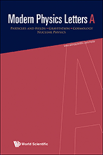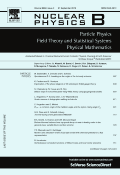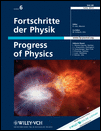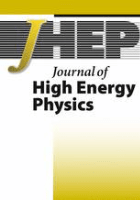
MODERN PHYSICS LETTERS A
Scope & Guideline
Exploring the Depths of Astrophysics and Nuclear Physics
Introduction
Aims and Scopes
- Theoretical Physics:
Research articles in theoretical physics explore fundamental concepts and frameworks, including quantum mechanics, general relativity, and advanced field theories. This includes studies on black holes, cosmology, and quantum gravity. - Astrophysics and Cosmology:
The journal features significant contributions to our understanding of the universe, including studies on dark matter, dark energy, cosmic inflation, and the behavior of celestial bodies under various physical conditions. - Quantum Information Science:
A core area includes the study of quantum information, quantum computing, and quantum cryptography, focusing on the principles that govern quantum systems and their applications in technology. - Particle Physics:
Research related to the fundamental particles of the universe, including their interactions and properties, as well as investigations into beyond the Standard Model physics, such as supersymmetry and leptoquark theories. - Interdisciplinary Applications:
The journal also welcomes research that bridges physics with other disciplines, applying physical principles to complex systems in biology, chemistry, and materials science.
Trending and Emerging
- Quantum Gravity and Black Hole Physics:
There is a notable increase in research focused on quantum gravity theories and black hole thermodynamics, particularly in the context of Hawking radiation and information paradoxes. - Dark Matter and Dark Energy Models:
Emerging studies are delving into novel models and theories that address the mysteries of dark matter and dark energy, often integrating insights from quantum mechanics and particle physics. - Quantum Computing and Information Technologies:
The journal is increasingly publishing works that explore quantum computing protocols, quantum cryptography, and the implications of quantum entanglement for secure communication. - Cosmological Simulations and Observational Studies:
There is a growing trend towards using sophisticated simulations and observational data to understand cosmic structure formation, inflationary models, and the dynamics of the universe. - Nonlinear Dynamics and Complex Systems:
Research in nonlinear dynamics, chaos theory, and their applications to various physical systems is gaining prominence, reflecting the interdisciplinary nature of modern physics.
Declining or Waning
- Classical Mechanics:
While foundational, studies in classical mechanics have decreased in prominence, as more researchers pivot towards quantum mechanics and relativistic frameworks. - Thermodynamics of Conventional Systems:
Research focusing solely on classical thermodynamic systems is becoming less frequent as the field shifts to explore thermodynamic aspects in quantum and relativistic contexts. - Static Models in Cosmology:
Traditional static cosmological models are waning in favor of dynamic models that incorporate time-dependent parameters and interactions within the expanding universe. - Basic Nuclear Physics:
Although still relevant, basic studies in nuclear physics are being overshadowed by more complex investigations into exotic states and interactions involving dark matter and energy.
Similar Journals

Science China-Physics Mechanics & Astronomy
Pioneering Research in Fundamental and Applied PhysicsScience China-Physics Mechanics & Astronomy, published by SCIENCE PRESS, stands as a prestigious journal within the Physics and Astronomy domain, particularly recognized for its contributions to the understanding of fundamental and applied physics. With an exhilarating Q1 ranking in the 2023 category and earning a remarkable scopus rank of #21 out of 243, the journal demonstrates its significant impact, being positioned in the 91st percentile of its field. Operating under an Open Access model, it facilitates the broad dissemination of high-quality research, ensuring accessibility for researchers, professionals, and students worldwide. Its scope covers a variety of essential topics in physics and astronomy, promoting a comprehensive understanding of the latest advancements from 2010 through 2024. The journal is a vital resource for anyone aiming to stay at the forefront of research in these dynamic fields, with its prominent address located in Beijing, China, symbolizing its global influence.

Physics of the Dark Universe
Bridging the Gap Between Light and Dark in AstronomyPhysics of the Dark Universe is a premier academic journal published by Elsevier, dedicated to advancing the understanding of dark matter, dark energy, and their implications for the universe. With its ISSN N/A and E-ISSN 2212-6864, the journal has established a notable presence since its inception in 2012, operating out of Amsterdam, Netherlands. As evidenced by its impressive impact factor and its ranking in the top quartile in both Astronomy and Astrophysics (Q1) and Space and Planetary Science (Q1) categories for 2023, this journal is a vital resource for researchers and practitioners within these fields. In the latest Scopus ranks, it ranks #12 out of 104 in Earth and Planetary Sciences and #13 out of 90 in Physics and Astronomy, placing it in the 88th and 86th percentiles respectively, underlining its academic significance. The journal is not Open Access, yet it plays an essential role in disseminating high-quality research that pushes the boundaries of knowledge about the cosmos and its most enigmatic components. Researchers, professionals, and students interested in the forefront of astrophysics will find this journal an indispensable tool for staying abreast of emerging discoveries and ongoing debates.

EUROPEAN PHYSICAL JOURNAL C
Advancing the Frontiers of Physics and EngineeringEUROPEAN PHYSICAL JOURNAL C (EPJ C), published by SPRINGER, stands as a premier platform for innovative research in the domains of Physics and Engineering. With its Open Access policy established in 2014, EPJ C ensures that groundbreaking findings are readily available to the global scientific community, enhancing accessibility and collaboration. The journal, indexed in prestigious databases, boasts an impressive impact factor and ranks within the Q1 category for both Engineering and Physics and Astronomy, placing it among the top-tier journals in these fields. Celebrated for its rigorous peer-review process, EPJ C offers a wide-ranging scope encompassing various topics in particle physics, quantum field theory, and related interdisciplinary studies. Its consistent publication since 1991 has fostered a vibrant community of researchers dedicated to advancing knowledge and innovation in physics and engineering. Join the scholarly discussion and contribute to the cutting-edge research made possible through EPJ C's esteemed platform.

Physics of Particles and Nuclei Letters
Exploring the Depths of Atomic SciencePhysics of Particles and Nuclei Letters, published by PLEIADES PUBLISHING INC, serves as a pivotal platform for the dissemination of cutting-edge research in the domains of particle and nuclear physics. With an ISSN of 1547-4771 and an E-ISSN of 1531-8567, this journal has been actively contributing to the scientific community since its inception in 2006 and continues to be influential, with a convergence period extending to 2024. While its open access options are limited, the journal is recognized for its rigorous peer-review process and commitment to quality, as reflected in its Scopus rankings across multiple categories, including a Q3 in Nuclear and High Energy Physics and Radiation in 2023. The journal is positioned to be a vital resource for researchers aiming to bridge theoretical understanding with practical applications in these highly specialized fields, fostering advances that resonate within atomic and molecular physics, radiology, and beyond. Its relevance continues to grow as the global scientific community seeks innovative solutions to complex problems in modern physics.

Particles
Unraveling Cosmic Mysteries Through Open Access Research.Particles is an esteemed open access journal published by MDPI, focusing on the dynamic fields of astronomy, astrophysics, and nuclear and high energy physics. Since its inception in 2019, the journal has made significant strides in contributing to scholarly discourse, achieving a commendable ranking in the Q2 category for its relevant fields as of 2023. With a commitment to disseminating high-quality research, it offers unrestricted access to a global audience, fostering collaboration and knowledge exchange among researchers, professionals, and students. Located in Basel, Switzerland, Particles serves as a platform for innovative research and discussions that leverage the latest advances in physics. Its current Scopus rankings underscore its impact and relevance, with notable positions in various categories within Physics and Astronomy. Through its rigorous peer-review process and diverse publication options, Particles continues to carve a niche in the academic landscape, catering to a growing community engaged in pioneering exploration of fundamental particles and cosmic phenomena.

NUCLEAR PHYSICS B
Exploring the Frontiers of Nuclear ResearchNUCLEAR PHYSICS B, published by Elsevier, stands at the forefront of research in the dynamic field of Nuclear and High Energy Physics. Established in 1967, this prestigious journal has developed a reputation for excellence, now positioned in the Q1 category according to its 2023 quartile rankings. With an impressive Scopus rank of #21 out of 87 in its category and a commendable 76th percentile, it serves as a vital resource for scholars investigating the underlying principles of nuclear interactions and particle physics. The journal transitioned to an Open Access model in 2014, ensuring that groundbreaking research is accessible to a global audience. Its commitment to quality and innovation makes NUCLEAR PHYSICS B an essential platform for researchers, professionals, and students aiming to stay at the cutting edge of discoveries in this expansive field, contributing to the scientific discourse for nearly six decades.

Gravitation & Cosmology
Innovating Insights in Astronomy and AstrophysicsGravitation & Cosmology is a vital academic journal founded to explore the profound concepts of gravitation and the dynamics of the universe. Published by MAIK NAUKA/INTERPERIODICA/SPRINGER, this journal features a comprehensive range of research articles, reviews, and theoretical insights that advance the field of astronomy and astrophysics. With a current impact factor reflective of its esteemed contribution, Gravitation & Cosmology operates within the upper tier of its discipline, classified as Q3 in Astronomy and Astrophysics for 2023. Although not an open-access publication, the journal fosters a vibrant community of scholars and practitioners by providing rigorous peer-reviewed content accessible through various academic platforms. Covering converged years from 2008 to 2024, this journal serves as an indispensable resource for anyone keen on deepening their understanding of gravitational phenomena and cosmological theories. Researchers, professionals, and students alike will find valuable insights and innovative research that push the boundaries of contemporary astrophysical knowledge.

FORTSCHRITTE DER PHYSIK-PROGRESS OF PHYSICS
Championing Excellence in Physics ScholarshipFORTSCHRITTE DER PHYSIK-PROGRESS OF PHYSICS, published by WILEY-V C H VERLAG GMBH, is a prestigious academic journal esteemed within the field of physics. With a history spanning over seven decades since its inception in 1953 and a converged publication up until 2024, this journal has established itself as a leading source for groundbreaking research and developments across diverse domains in physics and astronomy. Holding an influential Q1 ranking in the 2023 category of Physics and Astronomy (miscellaneous), it serves as an essential platform for disseminating high-quality research findings and theoretical advancements. Although not an Open Access publication, FORTSCHRITTE DER PHYSIK provides access to critical insights and scholarly discussions that are pivotal for researchers, professionals, and students alike. The journal is committed to contributing to the evolution of knowledge in physics, supporting the academic community through rigorous peer-reviewed articles, reviews, and innovative studies.

JOURNAL OF HIGH ENERGY PHYSICS
Catalyzing innovation in theoretical and experimental physics.JOURNAL OF HIGH ENERGY PHYSICS, published by SPRINGER, stands at the forefront of research in the fields of nuclear and high energy physics. With an impressive impact factor and a Scopus ranking of #5 out of 87 in its category, it sits comfortably in the 94th percentile of academic journals worldwide. Since its inception in 1997 and transitioning to Open Access in 2014, the journal has committed itself to the dissemination of peer-reviewed, cutting-edge research that fosters collaboration and innovation across the global scientific community. Located in Germany and reaching audiences worldwide, the journal aims to provide a platform for scholars and researchers to share their findings, thus propelling advancements in theoretical and experimental physics. As it converges into 2024, the JOURNAL OF HIGH ENERGY PHYSICS continues to be an essential resource for anyone engaged in this dynamic field of study.

Universe
Innovating the Future of Astronomy and Physics.Universe is a distinguished peer-reviewed journal published by MDPI, specializing in the dynamic fields of Physics and Astronomy. Established in 2015, this Open Access journal has rapidly gained recognition, achieving a prestigious Q1 quartile ranking in its category as of 2023. With its E-ISSN 2218-1997, the journal primarily serves the international scientific community, offering a platform for researchers to disseminate innovative ideas and findings. Based in Switzerland, Universe covers a wide range of topics within astronomy and astrophysics, ensuring that cutting-edge research is accessible to an ever-growing audience. Its commitment to open access principles since its inception allows for unrestricted dissemination of knowledge, fostering a collaborative environment essential for scientific advancement. By aligning its objectives with the promotion of high-quality research and interdisciplinary discourse, Universe stands as a vital resource for academics, professionals, and students aiming to contribute to and engage with the ever-evolving landscape of astronomical research.